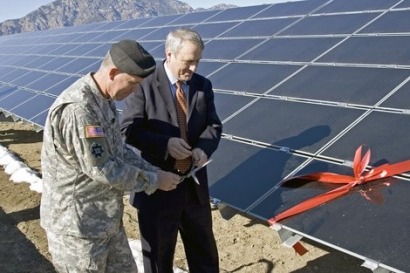
The aim is to replace around 8 percent of the Army’s current total installation energy use with renewable energy technology. The Net Zero Energy Installation (NZEI) sites have been designed to achieve net zero energy and have recently undergone trials in a series of pilot programmes, the findings from which have been outlined in a recently released report.
If all US Army installations worldwide were to achieve a 25 percent reduction in energy consumption, the Army would save around 20 trillion BTUs and up to $300 million in annual energy costs. The NZEIs studied by NREL employ technologies that can be replicated across the Department of Defense and other federal agencies, setting the stage for broad market adoption.
“It's been exciting to be a part of the net zero energy journeys of so many installations and to see the variety of approaches” said NREL Project Leader Sam Booth. “For example, Fort Hunter Liggett is on track to achieve net zero energy largely through many small projects, while Kwajalein is focused on achieving its net zero goal through a single large project.”
Six of the Army pilot sites focused solely on net zero energy. These are Camp Parks Reserve Forces Training Area (Calif.), Fort Detrick (Md.), Fort Hunter Liggett (Calif.), Kwajalein Atoll (Republic of the Marshal Islands), Sierra Army Depot (Calif.), and West Point (N.Y.).
Three other sites volunteered for unique net zero energy initiatives. Oregon Army National Guard is piloting a net zero energy initiative that includes all of its installations across the state. Fort Bliss (Texas) and Fort Carson (Colo.) are piloting integrated net zero energy, water, and waste programs.
The collaboration has found that NZEIs produce as much energy on site as they use throughout a year. They reduce their overall energy use by maximizing energy efficiency, energy recovery, and cogeneration opportunities, offsetting their remaining energy demand with on-site production of renewable energy. NREL supported the Army's NZEI pilot program by performing energy assessments that incorporate a mix of energy efficiency and renewable energy projects to meet the net zero energy goal at each location. The assessments identified energy efficiency projects to reduce demand and on-site renewable energy technologies to meet the remaining energy load.
The assessments also include system infrastructure, interconnection solutions, microgrid potential, and financing options. Key project development considerations included location and available renewable resources, the types of permits required, technical performance goals, and technology development partners.
While the initial installations were selected for the same end goal, the path to achieving net zero is unique to each installation. They all have different mission requirements, energy costs, building types and ages, renewable energy resources, and staff resources. This means that each NZEI has unique benchmarks and projects tailored to its location. Several of them have installed or have plans to install solar arrays of varying sizes.
The project has received funding support from the Energy Department's Office of Energy Efficiency and Renewable Energy alongside that provided by the US Army.
For additional information:

